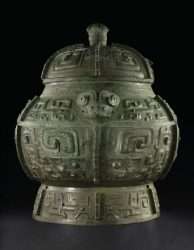The Great Bronze Age of China | Asia for Educators | Columbia University
The Great Bronze Age of China:
An Exhibition from the People's Republic of China
at The Metropolitan Museum of Art, New York
The Bronze Age was the time when men learned how to mine and smelt copper and tin to make bronze weapons and tools. These activities required an organized labor force and skilled craftsmen. In Neolithic times (before the Bronze Age), people had made tools out of stone and hunted and gathered their food. However, in the Bronze Age people learned how to farm and produce enough extra food to feed other workers — such as miners, bronze-smiths, weavers, potters and builders who lived in towns — and to feed the ruling class who organized and led society.
The Great Bronze Age of China had begun by 1700 B.C. in the kingdom of the Shang dynasty along the banks of the Yellow River in northern China. At times the Shang kings ruled even larger areas.
Contrary to common notions about the Chinese, the Bronze Age Chinese did not drink tea or eat rice. Both these commodities came from the south and were not popular in the rest of China until hundreds of years later. Instead the ordinary people consumed cereals, breads and cakes of millet and barley and drank beer. Members of the royal court could afford to vary their diet with meat and wine.
The Shang kings spent most of their time riding forth from their walled cities with their nobles and knights to hunt and fight wars. The farmers were peasants who belonged to the land and were supervised by vassals of the king. In many ways society in Bronze Age China resembles society in Medieval Europe. In the centuries after the Zhou dynasty (11th century B.C. to 221 B.C.) replaced the Shang kings, the lords and barons seized more and more power and became more and more independent.
During the Great Bronze Age of China the Chinese held extraordinarily different ideas about kingship and religion from Medieval Europe. They believed the king's right to rule was based on his good relations with the spirits of his ancestors who controlled the destiny of the domain. The king continually posed questions to his ancestors about policy. He did this by instructing his scribe to write the question on an "oracle bone" — that is, an animal shoulder blade or the breast bone of a turtle. A priest then held a hot rod to the bone until it cracked and interpreted the pattern of the cracks for the answer.
It was also the king's duty to please the great forces of nature — the sun and rain gods — who controlled the outcome of the harvest. So that these gods and his ancestor spirits would look favorably on his kingdom, the king made regular sacrifices of wine and cereals, which were placed in elaborate bronze vessels and heated over the fires on the temple altar. During the Shang dynasty bronze vessels were the symbol of royalty, just as the gold crown became the symbol of royalty in Europe. [Paragraphs 3, 4, 5, and 6 in the exhibition pamphlet describe the history and use of these bronzes.]
At times the Shang kings make animal and human sacrifices as well; and when the king and powerful members of the royal court died, it was not unusual that their wives, servants, bodyguards, horses and dogs were killed and buried with them. During the Zhou Dynasty people gradually turned away from this custom and substituted clay figures for real people and animals.
Leave a Reply